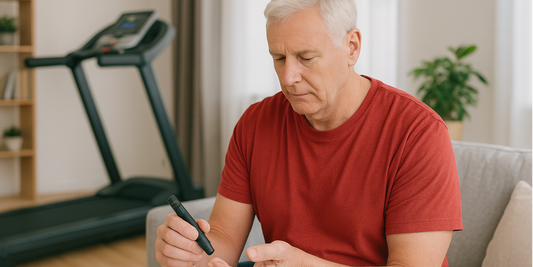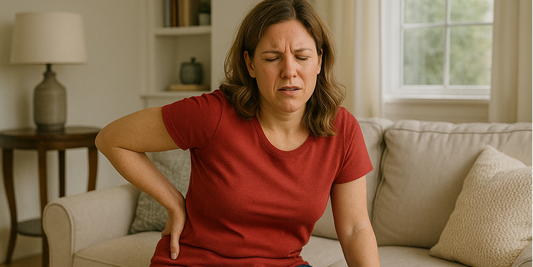
From Recovery to Mobility: Treadmill Tips for People Healing from Injury
Share
Recovering from an injury, illness, or surgery isn’t just about rest—it’s about smart, gentle movement. As your body heals, light exercise becomes essential to restore strength, improve circulation, and regain confidence in everyday movements. One of the most practical tools for rehabilitation at home is the treadmill.
With the right approach, treadmill walking can be safe, effective, and empowering. Whether you’re healing from a joint replacement, a fall, or a long hospital stay, a treadmill offers a controlled, low-impact environment to support your recovery step by step.
Why Choose a Treadmill for Recovery?

1 - Low Impact on Joints
After an injury, especially one involving the hips, knees, or spine, it’s crucial to avoid exercises that put too much pressure on the joints. Treadmills offer a softer surface compared to outdoor pavement or tile floors. This reduces the force on your joints with every step and lowers the risk of re-injury.
Most recovery-friendly treadmills also have shock absorption features, which cushion your stride and allow for smoother, safer movement. That’s why many physical therapists recommend treadmill walking as an early-stage activity after orthopedic surgery or injury.
2 - Controlled Environment
When walking outdoors, you may face uneven terrain, stairs, curbs, or even unpredictable weather. For someone recovering from an injury, these are potential hazards. Treadmills, on the other hand, allow you to control every element such as speed, incline, duration, and rest.
This makes it easier to follow a gradual, structured progression. You can start with just 5 minutes a day at a very low speed and slowly increase your sessions based on how you feel. You’re in full control, and that can go a long way toward rebuilding both physical ability and confidence.
3 - Helps Circulation and Mobility
Gentle movement helps increase blood flow, which promotes healing. When you walk even slowly, you activate your leg muscles, stimulate circulation, and prevent stiffness from settling in. This is especially important if you’ve spent time bedridden or sedentary during the early stages of recovery.
Treadmill walking also helps retrain your coordination and balance, especially after surgeries like hip or knee replacements. Your muscles "remember" how to move through repetition, and a treadmill gives you a safe place to do just that.
Getting Started: Safety First

1 - Check with Your Doctor
Before beginning any treadmill or walking routine, especially after surgery or a serious injury, talk to your healthcare provider. They can assess your healing progress and let you know if you're ready to begin light movement. In some cases, your doctor may also refer you to a physical therapist to help guide your exercise plan.
Be sure to ask what your limitations are, how fast, how long, and what warning signs to watch out for. It's always better to ease in with professional guidance than to guess and risk setting back your recovery.
2 - Start Slow and Steady
Don’t rush the process. Your first few sessions might be just five minutes long at a pace slower than a typical walk. That’s perfectly fine. The goal is to reintroduce movement without pain, strain, or fatigue.
Set the treadmill to the lowest speed (usually around 0.5 to 1.0 mph) and keep the incline at zero. Use the handrails to help with balance and stability. Over time, as your strength and endurance improve, you can gradually increase your walking time and speed under your doctor's guidance.
Tips for Safe and Effective Treadmill Use During Rehab

1 - Use the Handrails for Stability
Especially during the first few weeks, use the side rails or front bar to help with balance. Avoid leaning too heavily; try to walk upright with light support. As you get stronger, practice walking without holding on for short intervals to improve core stability.
2 - Watch Your Posture
Proper posture reduces tension on your back and shoulders. Keep your head lifted, shoulders relaxed, and core gently engaged. Try to look straight ahead instead of down at your feet or the screen.
3 - Wear Proper Footwear
Supportive walking shoes with cushioning and grip are essential. Avoid walking barefoot or in house slippers, even indoors. Proper footwear helps absorb impact and prevent slips.
4 - Listen to Your Body
A little soreness is normal, but sharp pain, dizziness, or unusual fatigue is a red flag. Stop immediately if you feel discomfort beyond what your doctor or therapist has explained is normal. Track your symptoms and share them during follow-ups.
5 - Don’t Increase Too Quickly
While it’s tempting to “do more” on good days, resist the urge to double your time or speed. Stick to a gradual progression, adding just 1 to 2 minutes or a small increase in speed per week. Recovery is a marathon, not a sprint.
Track Your Progress and Celebrate Small Wins
 Rehabilitation can feel slow and sometimes frustrating, but progress is still happening. Keeping track of your sessions can give you motivation and a sense of achievement. Use a simple notebook, a digital journal, or the treadmill’s built-in monitor to log each walk.
Rehabilitation can feel slow and sometimes frustrating, but progress is still happening. Keeping track of your sessions can give you motivation and a sense of achievement. Use a simple notebook, a digital journal, or the treadmill’s built-in monitor to log each walk.
Track time, speed, how you felt, and any improvements you notice. Did you walk a full 10 minutes today for the first time? Did you reduce how often you had to hold the handrails? These are real signs of healing and deserve to be celebrated.
You can also set small goals:
- “Walk 10 minutes without stopping.”
- “Walk 5 days this week.”
- “Increase by 1 minute next week.”
Celebrate each win, no matter how small, because they’re all stepping stones to full recovery.
Conclusion
Recovery takes time, but with gentle movement and the right tools, you can rebuild strength and confidence. Treadmill walking offers a safe, effective way to support healing and regain mobility at your own pace.
For extra safety, consider a treadmill with handrails like the Redliro Walking Treadmill with Long Handrail. Its supportive design, low step height, and simple controls make it a great choice for anyone in recovery looking to stay active at home.



